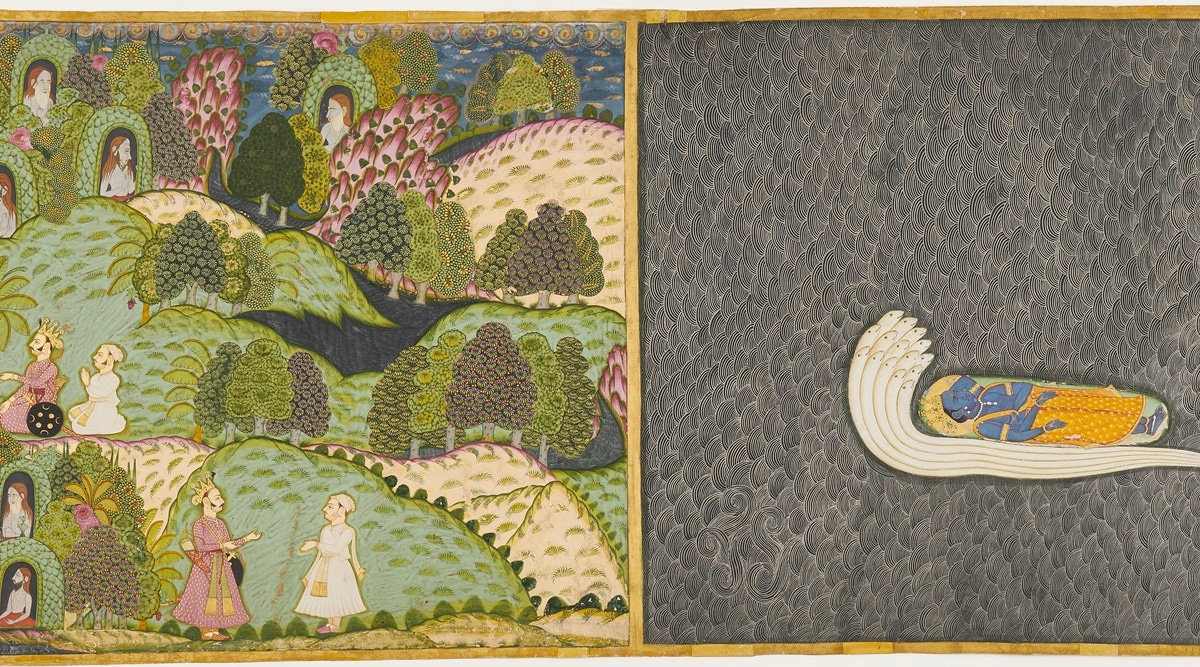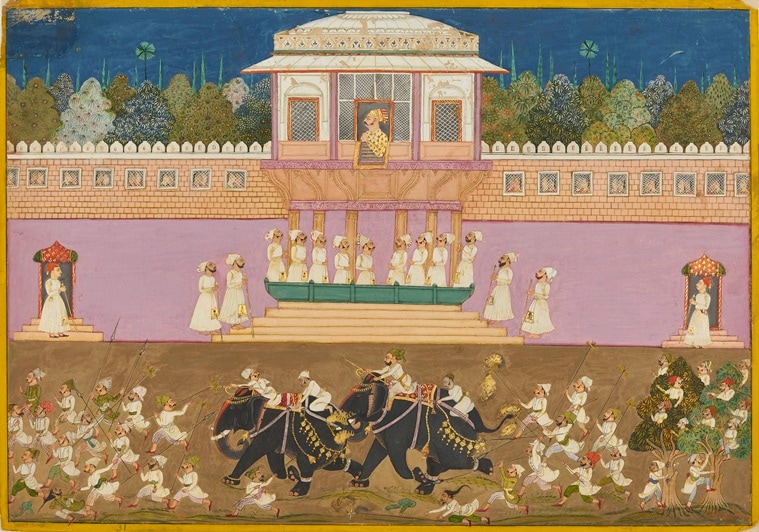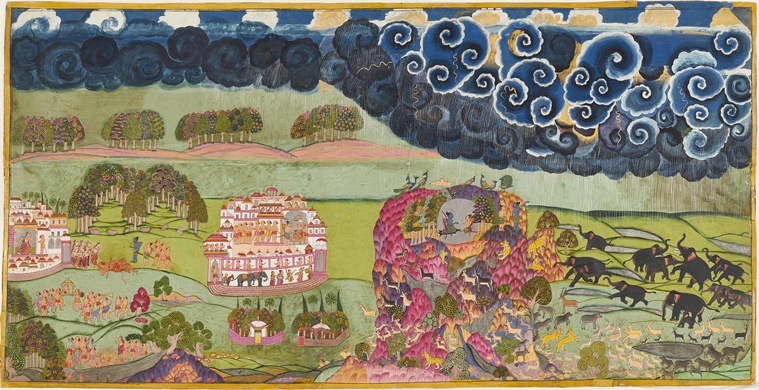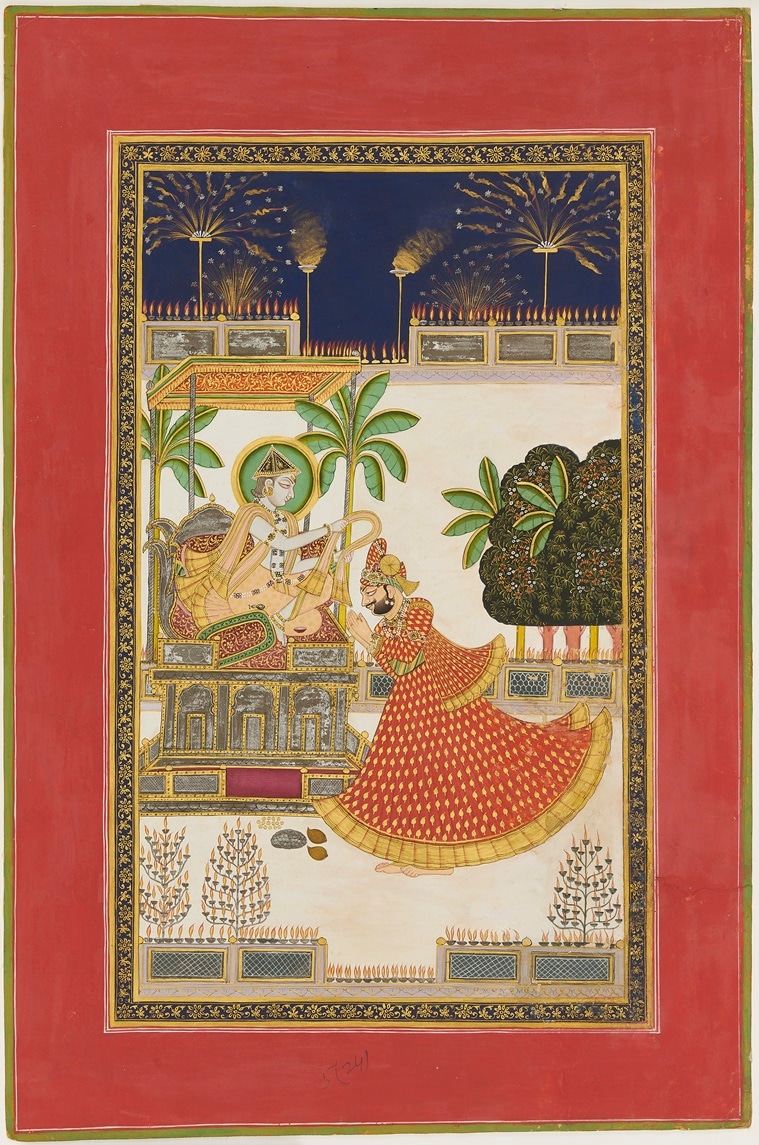 Sage Markandeya’s Ashram and the Milky Ocean, Jodhpur (c. 1780-90). (Courtesy: Mehrangarh Museum Trust)
Sage Markandeya’s Ashram and the Milky Ocean, Jodhpur (c. 1780-90). (Courtesy: Mehrangarh Museum Trust)Vivid scenes of a hermitage in a lush forest, Diwali celebrations on a palace terrace, and elephants running amok in a fort — it is hard to imagine that these paintings from the erstwhile Kingdom of Marwar convey the political underpinnings of the maharajas’ reigns. Yet, it is very much the case, as scholars observe in ‘Garden & Cosmos: The Royal Paintings of Jodhpur-Marwar’, on view at the Chhatrapati Shivaji Maharaj Vastu Sangrahalaya (CSMVS) in Mumbai till October 31.
‘Garden & Cosmos’ highlights the earthly and spiritual preoccupations of three maharajas —Bakhat Singh (1706-52), his son Vijai Singh (1729-93) and his great-grandson, Man Singh (1783-1843). Despite battles, conspiracies, court intrigues and other kingly pursuits, these maharajas of Jodhpur-Marwar produced intricate and complex paintings in the royal ateliers at Jodhpur and Nagaur.
 Maharaja Bakhat Singh watches elephants wreaking havoc, Nagaur (c. 1740). (Courtesy: Mehrangarh Museum Trust)
Maharaja Bakhat Singh watches elephants wreaking havoc, Nagaur (c. 1740). (Courtesy: Mehrangarh Museum Trust) Sabyasachi Mukherjee, the director of CSMVS, said, “The paintings are visually stunning, intellectually engaging, and equally appealing to the wider audience with their spectacular monumental scale. They depict the relevance of the garden in the arid landscape of Jodhpur, its elegant architecture, and its royal patronage of the environment historically.”
The work that sets the tone for the exhibition is ‘Sage Markandeya’s Ashram and the Milky Ocean’, a late 18th-century folio based on the Devi Mahatmya. Created during Vijai Singh’s reign, it depicts a king and merchant who seek release from worldly attachments and approach sage Medha. The dense sylvan setting on the folio’s left side is in stark contrast with the right, where Vishnu sleeps on his serpent in an expanse. ‘Garden & Cosmos’ continues in this vein, shifting between maximalist verdant spaces and minimalist cosmic oceans. “The exhibition brings out the sacredness of the Absolute. In this folio, the depiction of worldly life as well as heavenly life is incorporated in one folio,” said assistant curator Mrinalini Pathak, who will conduct a walkthrough of ‘Garden & Cosmos’ on October 14.
 Rama and Lakshmana wait out the monsoon, Jodhpur (c. 1775), (Courtesy: Mehrangarh Museum Trust)
Rama and Lakshmana wait out the monsoon, Jodhpur (c. 1775), (Courtesy: Mehrangarh Museum Trust) ‘Garden & Cosmos’ debuted in 2008 at the National Museum of Asian Art at the Smithsonian Institute in the US, with 55 paintings from the Mehrangarh Museum Trust in Jodhpur. It was curated by Debra Diamond, currently a curator of South and Southeast Asian art at the Smithsonian’s National Museum of Asian Art. Diamond researched the paintings with Karni Singh Jasol, the late director of the Mehrangarh Museum Trust, and scholar Catherine Glynn. After touring three international museums till 2009, the paintings returned to India, and an abridged version of the exhibition was on view at the Mehrangarh Fort Museum. It is only now that it has come to another Indian museum.
Of the 33 paintings on display at CSMVS, a sizeable number are from Man Singh’s reign. The story goes that Man Singh was the heir apparent but a ruthless uncle sought to usurp the throne. Man Singh decided to surrender in 1803 but a prophetic message from a Nath mahasiddha (an immortal ascetic) asked him to delay until Diwali. As it turned out, his uncle died within days and Man Singh laid his claim to the throne. The royal atelier henceforth proclaimed the greatness of the Naths. Many such examples are available in the exhibition, including one that depicts the incident from 1803.
 Mahasiddha Jallandharnath and Maharaja Man Singh on Diwali, Marwar region (c. 1820). (Courtesy: Mehrangarh Museum Trust)
Mahasiddha Jallandharnath and Maharaja Man Singh on Diwali, Marwar region (c. 1820). (Courtesy: Mehrangarh Museum Trust) The theme of the garden is most present in the paintings made in Bakhat Singh’s atelier in Nagaur. The maharaja often sought to make himself the hero of these portable paintings, and he appears in them in many roles, including that of a lover in a garden. Nagaur had long been under the Delhi Sultanate and Mughal influences were found plenty in its art and architecture. The paintings from the royal atelier here reflected the same.
Across these paintings, it’s interesting to note the dynamic landscape of Jodhpur-Marwar. Pinkish-purple hills and mountains pop out of some paintings. Sunayana Rathore, deputy editor of the Mehrangarh Museum Trust, said, “When sunlight falls on the red sandstone of the Jodhpur Fort and other structures, they look pink, which is why the painters have tried to do the same. It was typical of the Marwar school.”